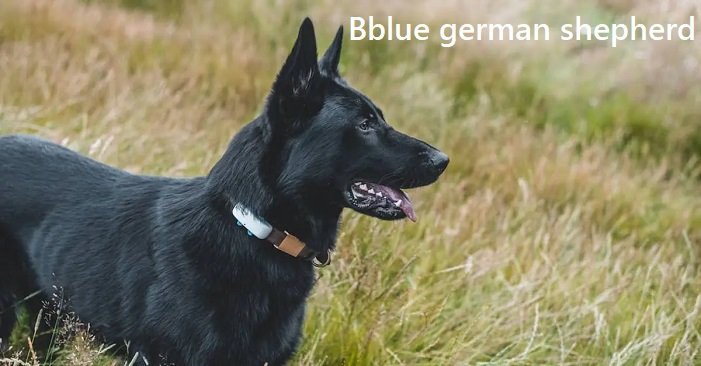Blue German Shepherd: The Rare Beauty Every Dog Lover Needs to Know About

If you’re familiar with German Shepherds, you already know they’re one of the most intelligent, loyal, and versatile dog breeds out there. But have you ever heard of the Blue German Shepherd? If not, you’re in for a surprise.
These rare dogs aren’t just beautiful—they’re everything you love about a German Shepherd with a unique twist. Having had experience with these stunning creatures, let me break down everything you need to know about them.
What Makes a Blue German Shepherd So Special?
The Blue German Shepherd isn’t a separate breed from the standard German Shepherd, but their distinctive blue-gray coat sets them apart.
The “blue” color comes from a recessive gene that dilutes the black pigment, giving their fur a gorgeous, steel-blue hue. This rare coat color can be light or dark, but it’s always striking and guaranteed to turn heads.
Why Are They So Rare?
The blue color in German Shepherds is caused by a genetic mutation, and it’s incredibly rare. For a German Shepherd to have a blue coat, both parents must carry the recessive gene responsible for the color.
This rarity makes finding a Blue German Shepherd a bit of a challenge—and often, more expensive than their standard black-and-tan counterparts.
Do Blue German Shepherds Have the Same Traits?
Absolutely. Blue German Shepherds share all the same characteristics that make the breed so popular:
- Loyalty: Like all German Shepherds, they’re fiercely loyal and form strong bonds with their family.
- Intelligence: Blue German Shepherds are just as smart, making them highly trainable and excellent working dogs.
- Protectiveness: They’re natural protectors and will watch over your home and family.
- Versatility: Whether you need a family pet, a service dog, or a working dog, Blue German Shepherds are up for the task.
The only difference between a Blue German Shepherd and a regular German Shepherd is the color of their coat—everything else remains the same.
Are Blue German Shepherds Recognized by Kennel Clubs?
Here’s the catch: while the American Kennel Club (AKC) recognizes the German Shepherd breed, they don’t accept blue as a standard color for show dogs.
However, this doesn’t mean Blue German Shepherds can’t participate in other competitions like obedience or agility. So if you’re not planning on entering conformation shows, this shouldn’t be a concern.
Temperament: No Surprises Here!
If you’ve had any experience with German Shepherds, you’ll feel right at home with a Blue German Shepherd. They’re known for their calm and confident demeanor, but they also have a strong protective instinct.
With proper socialization and training, these dogs make incredible companions for families, singles, and even first-time dog owners.
Health and Lifespan of a Blue German Shepherd
Blue German Shepherds generally have the same health profile as other German Shepherds. They can live up to 9–13 years with proper care, but there are some health concerns to keep in mind:
- Hip Dysplasia: This is a common issue in German Shepherds due to their size.
- Elbow Dysplasia: Similar to hip dysplasia, this can cause joint pain as the dog ages.
- Degenerative Myelopathy: A condition that affects the spinal cord, leading to mobility issues later in life.
Make sure to choose a reputable breeder who screens for these genetic conditions. Regular vet check-ups and a healthy lifestyle will go a long way in keeping your Blue German Shepherd happy and healthy.
Caring for a Blue German Shepherd’s Coat
One thing I’ve noticed about Blue German Shepherds is that their coat requires the same level of care as any other German Shepherd.
Since they are heavy shedders, especially during seasonal changes, regular grooming is a must. Here’s my advice for keeping that gorgeous blue coat looking its best:
- Brush frequently: Aim to brush them 2–3 times a week to manage shedding and keep their coat smooth and tangle-free.
- Bathing: Only bathe them when necessary, as frequent bathing can strip their coat of natural oils.
- Nail trimming and ear cleaning: Regular grooming isn’t just about the coat—make sure to check their nails and ears regularly to avoid infections or other issues.
How to Find a Blue German Shepherd
Given their rarity, finding a Blue German Shepherd might take some time and patience. You’ll likely need to seek out breeders who specialize in this color variation. Be prepared for higher prices due to the demand and uniqueness of these dogs.
Is a Blue German Shepherd Right for You?
Before getting swept away by their stunning looks, it’s important to consider if a Blue German Shepherd fits your lifestyle. These dogs are highly active and require regular physical and mental stimulation.
If you enjoy outdoor activities, have time for consistent training, and are looking for a loyal companion, a Blue German Shepherd could be perfect for you.
However, if you’re not prepared to handle an active, protective breed, or don’t have the time to dedicate to their care, it might be worth considering another breed.
My Final Thoughts on the Blue German Shepherd
As someone who has had the pleasure of spending time with Blue German Shepherds, I can confidently say that they are truly special. Their rare blue coat is just the cherry on top of an already amazing breed.
Whether you’re looking for a loyal family pet or a dedicated working dog, a Blue German Shepherd will not disappoint. They’re everything you love about German Shepherds with an extra dash of beauty.
If you’re lucky enough to come across one, don’t hesitate—they’re worth every minute of the wait!




